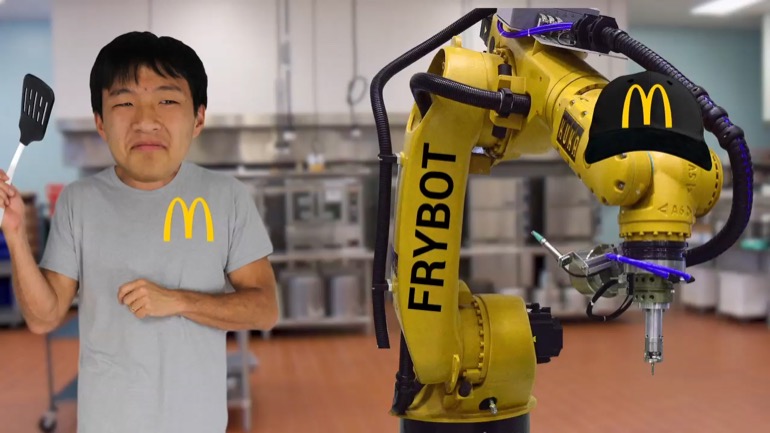ShmoopTube
Where Monty Python meets your 10th grade teacher.
Search Thousands of Shmoop Videos
Econ Videos 79 videos
What is a Production Possibilities Curve? The Production Possibilities Frontier Curve (PPF) is a statistical graphic curve that depicts the compari...
What are Income and Substitution Effects? Income effects reflects the increases or decreases in total consumption of goods and services in proporti...
How Do Companies Add Value? Companies add value by improving the client or customer experience. This can be achieved by offering better quality ser...
Econ: What are Marginal Product of Capital and Marginal Product of Labor? 2 Views
Share It!
Description:
What is Marginal Product of Capital? Marginal product of capital is how much a company can increase their production by if they add one unit of capital. This figure can be found after a company buys a new piece of machinery; the change in production resulting from adding that new piece of machinery is referred to as the marginal product of capital.
Transcript
- 00:00
and finance Allah shmoop What are marginal product of capital
- 00:05
and marginal product of labor You know those silly economists
- 00:12
always thinking on the margin and about inputs and outputs
- 00:16
if you're not in the know while thinking on the
- 00:18
margin means thinking about an additional unit of something like
Full Transcript
- 00:22
inputs sometimes called factors are the things firms used Teo
- 00:26
make stuff to sell An output is thie ending product
- 00:29
that goes to the consumer market called product by firms
- 00:33
The marginal product of capital asks how much more product
- 00:36
the output would we have if we added one more
- 00:40
unit of capital to the production process Well the marginal
- 00:44
product of labour is the same except while we switch
- 00:46
the input of capital with the input of labor the
- 00:49
marginal product of labour asks How much more output would
- 00:53
we have if we added one more unit of Labour
- 00:56
into the system Well with both of these were not
- 00:58
looking at total output but rather how much more we
- 01:01
get if we tinker around with our inputs of it
- 01:03
So let's take a look at man's best friend to
- 01:05
see how marginal product of capital in marginal product of
- 01:08
labour interact And no we don't mean dogs We're talking
- 01:11
about the one in your pocket Yes your phone In
- 01:13
a cellphone factory you've gotten assembly line with embryonic phones
- 01:17
making their way through the production process On that assembly
- 01:20
line there's a mix of humans and robots each specialized
- 01:23
in an area of phone production A firm has the
- 01:26
goal of increasing profits which means reducing costs as much
- 01:30
as possible and increasing revenues as much as possible So
- 01:33
sure having the assembly line helps But what mix of
- 01:37
robots and humans will cost the least or have the
- 01:40
least expense Well that's where the least cost rule comes
- 01:43
into play and least cost Rule says that to minimise
- 01:46
costs you find the amount of marginal product that a
- 01:49
dollar spent on each input type makes and then you
- 01:52
set them equal to each other at the phone Jess
- 01:55
Station Factory Well that means the firm can figure out
- 01:57
how many workers to hire and how many machines to
- 02:00
rent to minimise costs So let's take a look The
- 02:03
firm's handy dandy marginal product chart If we look at
- 02:06
the marginal product of laborers and the marginal product of
- 02:08
machines Well we can see each additional one of them
- 02:11
yields less and less marginal output That's the law of
- 02:14
diminishing marginal returns rearing its ugly head If laborers cost
- 02:19
ten bucks an hour and machines can be rented for
- 02:21
eight bucks an hour then we can calculate the marginal
- 02:24
product a price ratio for each quiz time How many
- 02:27
workers and how many robots will the firm hire Well
- 02:30
remember firms can get the most bang for their buck
- 02:32
by employing the quantity of inputs where their marginal product
- 02:36
to price ratio equals each other depending on how much
- 02:39
money the firm has Well it has a few different
- 02:41
options The phone firm could hire one worker into machines
- 02:44
each which have a marginal product to price ratio up
- 02:46
Six Let's think about what that means for a minute
- 02:49
The first worker hired would result in a marginal product
- 02:51
of sixty sixty units still adding sixty more phones to
- 02:54
total output But at what cost Ten bucks Six additional
- 02:58
phones per dollar Well the first machine is adding sixty
- 03:01
four more phones to total output for eight bucks which
- 03:04
means eight more phones per dollar Eight more phones for
- 03:07
dollars better than six phones for dollar right So we
- 03:10
hire a second robot A second robot will only bring
- 03:13
in an additional forty eight phones and it still cost
- 03:16
eight bucks to rent So for the second phone assembling
- 03:18
robot that's forty eight divided by eight dollars That's six
- 03:21
additional phones per dollar spent who Wait a minute here
- 03:25
That's the same marginal product to price ratio As the
- 03:28
first human you might be thinking Why not just hire
- 03:31
all robots Well because hiring the first worker is a
- 03:35
better deal than hiring the third robot Hiring the first
- 03:38
worker gets you six phones per dollar and the third
- 03:41
robot gets you only four phones per dollar which is
- 03:44
why the least cost rule here works If your MP
- 03:48
over peas are unequal it means you're missing out on
- 03:51
a more cost effective input combo if the phone firm
- 03:54
has more money while it could hire where MP Over
- 03:57
P is for which means to workers and three machines
- 03:59
and could also higher where MP p o ver p
- 04:01
equals two which means three workers in four machines firms
- 04:05
have to know their marginal product of capital in marginal
- 04:07
product of labour so they can tinker with the numbers
- 04:10
finding the least cost way to produce their product because
- 04:13
otherwise some other firm will be finding a lower cost
- 04:15
way to make the product they could then use that
- 04:17
advantage toe undercut competitors pushing them out of the market
- 04:21
It's kind of like Survivor but with firms everybody's gotta
- 04:23
stay neck and neck to keep their skin in the
- 04:25
game or else you know they'LL get voted off the
- 04:28
island So if you're a firm tinker away with marginal
- 04:31
product and hopefully you'LL never hear the words of the 00:04:33.597 --> [endTime] tribe has spoken What
Related Videos
GED Social Studies 1.1 Civics and Government
What is bankruptcy? Deadbeats who can't pay their bills declare bankruptcy. Either they borrowed too much money, or the business fell apart. They t...
What's a dividend? At will, the board of directors can pay a dividend on common stock. Usually, that payout is some percentage less than 100 of ear...
How are risk and reward related? Take more risk, expect more reward. A lottery ticket might be worth a billion dollars, but if the odds are one in...



















































































